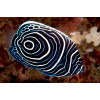Size: only S,M
Species Name: Pomacanthus Imperator
Care Level : Moderate
Temperament : Semi-aggressive
Color : Black, Blue, White
Diet : Omnivore
Reef Compatible : With Caution
Water Conditions : sg 1.020-1.025, 72-78° F, dKH 8-12, pH 8.1-8.4
Max. Size : 1' 3"
Origin : Africa, Fiji, Indonesia, Maldives, Sri Lanka
Family : Pomacanthidae
Minimum Tank Size : 220 gallons
The adult Emperor Angelfish (Pomacanthus Imperator), also called the Imperator Angelfish, has a bold, blue body covered with bright yellow horizontal stripes culminating in a bright yellow to orange caudal fin. A striking blue-black mask covers the eyes and a similarly-colored vertical band extends from the pectoral fin two-thirds of the way up the body. This band is highlighted in a sapphire-blue in front, and bright yellow, caudally. The mouth is white. This species attains a maximum total length of 13 inches.
The juvenile is black with circular white and blue stripes starting at the tail. Although sought after for its colors, in captivity, the adult coloration may not be as striking or brilliant. The changing angelfish will vary in coloration and pattern as it transforms from juvenile to the adult coloration.
The Emperor Angelfish requires a 220 gallon or larger tank with live rock for grazing and hiding. They also require extensive rockwork and deep caves to feel secure.
These fish are very territorial and semi-aggressive. Due to their semi-aggressive nature, you have to be extra cautious about tank mates. Generally, it’s best to introduce Emperor Angelfish last in a community tank. This can help reduce the chance of them displaying territorial behavior. Most large angelfish are well known for nipping at large-polyped stony corals and some soft corals (e.g. Xenia) as well as tridacnid clam mantles. It is not considered reef safe though some specimens have been reported to live peacefully without harassing small-polyped stony corals and soft corals of a more 'noxious' nature.
Emperor Angelfish are omnivores. It should be fed a diet of Spirulina, marine algae, high-quality angelfish preparations, mysis or frozen shrimp, and other meaty items. During the first few weeks of being in your aquarium, feed the fish about five small meals a day. Then, slowly transition to three meals.
-
There are no reviews for this product.
-
No questions yet


